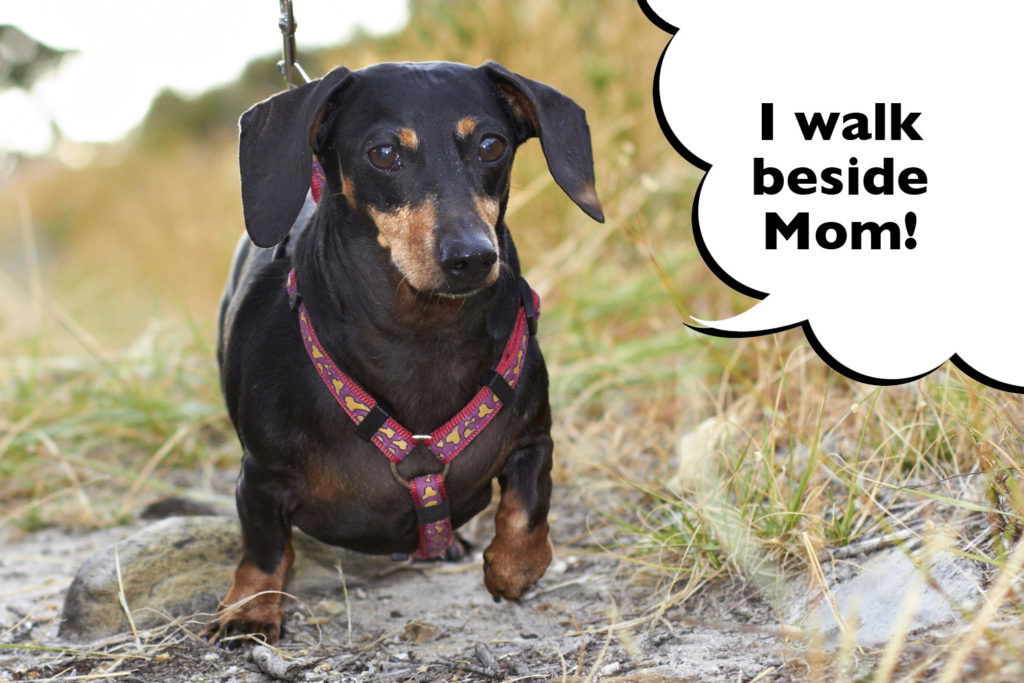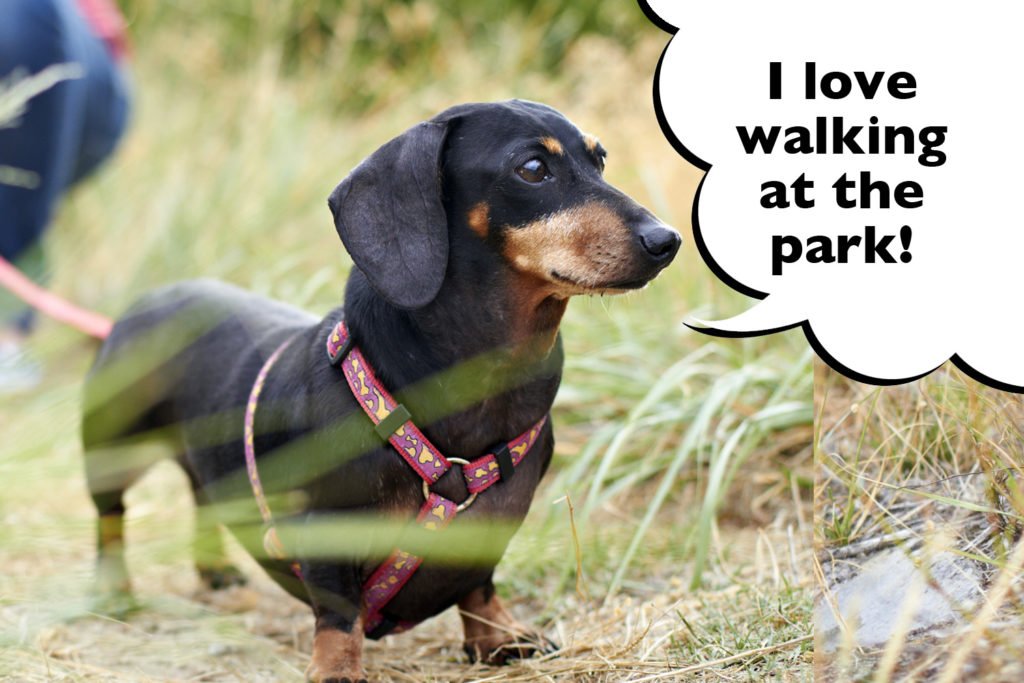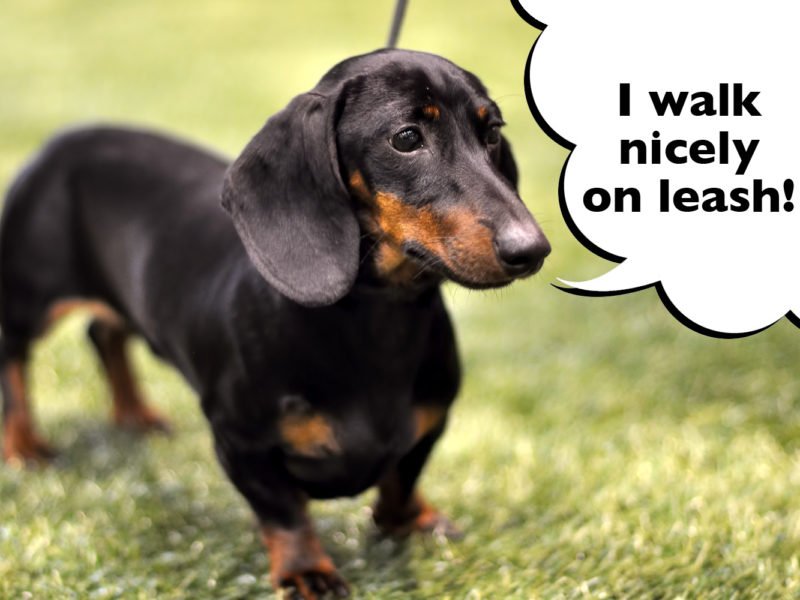Do you have a Dachshund puppy who’s ready to venture into the outside world? Are you wondering how to teach a Dachshund to walk nicely on a leash without pulling? Here’s everything you need to know about Dachshunds and leash training.
How Do You Teach a Dachshund to Walk on Leash?
- Get your Dachshund used to wearing the gear
- Exercise your Dachshund before leash training
- Keep training sessions short
- Find a quiet space without distractions
- Put your Dachshund’s leash and collar or harness on
- Get your Dachshund to stand on your left
- Slowly walk forwards for a few metres
- Stop and ask your Dachshund to ‘Sit!’
- Treat and praise
- Repeat until your Dachshund is confident
- Leave your front door
- Start using the word ‘Heel!’
- Increase the distance
- Introduce distractions
- Get a dog walking buddy
- Stay calm at all times
- Have patience!
But, before you clip on the leash and start walking down the road, there’s more you need to know! Read on to find out what you need to buy, how to teach your Dachshund to walk on a leash and how to stop him pulling!
Table of Contents
This article is based on research and personal experience as a Dachshund owner of 10+ years. I’m not a Vet, qualified dog trainer or dog behaviourist.
Is Your Dachshund Ready For Leash Training?
Before you start leash training, you need to teach your Dachshund the basic commands. Things like ‘Sit!’, ‘Stay!’, Leave!’, ‘Look at me!’ and ‘Come!’ etc. You can teach him inside the home or a secure garden or yard (NOT off leash in the park!).
You’ll be way more successful with your Dachshund’s leash training if you’ve mastered basic obedience first.
It’s SO important to teach a young puppy to respond to your commands, even when you’re outdoors and there are lots of smells and distractions around.
After all, leash training isn’t about the leash, the harness, the location or the distractions. It’s actually about the bond between you and your Dachshund, and whether you can hold his attention for long enough to get him to do what you want.
What Age Can A Dachshund Start Leash Training?
Dachshunds can start leash training at home from 8 to 12 weeks old. However, be very careful not to tug or pull at his leash. Dachshunds have fragile backs that are especially vulnerable while they’re young. Don’t leash train away from home until your Dachshund has had all his jabs.
What Do You Need To Leash Train A Dachshund?
Firs things first, you need to buy the right equipment for your Dachshund’s leash training:
A collar or harness
You can either use a collar or a harness for walking your Dachshund. A lot of owners prefer harnesses because they spread the pull of the leash across a Dachshund’s chest and back, which takes some of the strain off his fragile back.
Whichever option you choose, the most important thing is that it fits properly. Your Dachshund’s lower back is super injury-prone and, if the collar or harness isn’t right, he could potentially hurt his back.
For the collar, it mustn’t be too loose so your Dachshund can slip out, or too tight so it’s restrictive. You should be able to slip 2 fingers between his neck and collar. If you can’t, let it out a little bit and then check again.
To measure your Dachshund for a harness, you’ll need to know his neck size, girth measurement and his length (from the base of his neck to the top of his tail), and then check the manufacturer’s size guide.
You could also go to a pet store where they’ll measure and fit your Dachshund’s harness for you. Getting it wrong could result in open sores or chaffing under the legs, so it’s worth double checking the fit of the harness is right.
A leash
You’ll also need a leash that clips securely onto your Dachshund’s collar or harness. For leash training, it’s best to stay away from retractable leashes, as you want to keep your Dachshund nice and close to you while he’s learning.
Your Dachshund could seriously injure himself if he runs after another dog or a squirrel while on a retractable leash (a real possibility while he’s still training!).
Bear in mind that the jolt at the end of a long leash could be very damaging to a Dachshund’s back.
Training treats
You’ll also need a stash of bite-sized treats in your pocket or pouch for when you’re leash training your Dachshund.
It may seem like you’re giving lots of treats and rewards at first, but you can gradually wean your Dachshund off them when he learns to walk nicely by your side.

How To Train A Dachshund To Walk On Leash
This is how to train a Dachshund to walk on leash:
Get your Dachshund used to wearing the leash and collar or harness
Before you can set off down the road, your Dachshund needs to be happy wearing his leash, as well as his collar or harness.
It sounds obvious, but if your Dachshund is uncomfortable or freaked out by the extra weight on his little body, then he probably won’t walk!
Start by calmly popping on his collar or harness for him to wear around the house to get him used to how it feels.
Don’t make a big deal of it. Just potter around the house and hopefully he’ll realise it’s totally normal and nothing to be scared of.
If your Dachshund freaks out whenever you pick up his collar or harness, you’ll need to work through this with him before you move onto outdoor leash training.
Do short sessions and take it slow. Start by letting him smell the collar or harness, and build up his confidence so that he eventually lets you touch him gently with it.
Once your Dachshund is happy wearing his collar or harness inside the home, try clipping on his leash and letting him wander around the room with it on (supervising him so he doesn’t get tangled!).
Eventually you’ll get to the point where you can loosely pick up your Dachshund’s leash and walk from one room to the other. This’ll help build confidence before venturing into the outside world.
Exercise your Dachshund before leash training
Dachshunds (and especially puppies!) can be little bundles of energy. So, before you start leash training outside, it’s best to give him a little run around in the garden or yard.
You want to use up some of that excess energy. That way, when it comes to training time, more of his attention is focussed on YOU!
Keep training sessions short
Your Dachshund will learn leash walking best if you keep his training sessions short and focused.
If you can manage at least two 5 minute sessions each day, that’s perfect! He may get bored or distracted with longer sessions, so keep things short to start with.
Don’t overdo the exercise with Dachshund puppies. Stick to the 5 minutes per month of age rule during those first 12 months.
Find a quiet space without distractions
Your Dachshund will find it easier to learn leash training in a quiet space that’s free from distractions. This’ll help him focus on YOU and pick up his training faster.
You could start in your back yard or garden if you have one, or anywhere safe that you know won’t be full of people and other dogs. You could even start inside your home.
Ideally, a place that isn’t grass would be better, as there are so many smells in grass that could distract your Dachshund when you’re trying to train him.
As your Dachshund gets the hang of things, you can then start taking him to new locations for leash training sessions (after jabs of course!).
This’ll help keep his training interesting and let you gradually introduce new types of distractions, so he gets used to walking nicely wherever you are.

Put the leash and collar or harness on your Dachshund
Once you’re in a quiet space and your Dachshund is calm, you can pop on his leash and collar (or harness).
Get your Dachshund to stand on your left
Get your Dachshund to stand on your left hand side, and pop the leash into your right hand.
Don’t start walking right away. Get your Dachshund to stand beside you and then ask him to ‘Sit!’ and ‘Stay!’. Keep him in that position for a few seconds before giving him a treat and fuss.
You basically want to keep your Dachshund’s attention on YOU, and away from all the other smells and distractions outside.
Slowly walk forward
Starting with your left foot (so your Dachshund can see it), walk slowly forwards for a few metres. Hopefully your Dachshund will start walking too.
If he does start walking with you, give him a treat and praise to show him that he’s doing things right.
Even though Dachshunds have little legs, they can actually walk quite fast. So remember to keep things at a steady pace.
Stop and ask your Dachshund to ‘Sit!’
After a few metres, ask your Dachshund to ‘Sit!’ and ‘Stay!’ again. Keep stopping and starting over and over, and treating him when he gives you his attention.
You don’t want your Dachshund to get overexcited and start pulling on his leash or rushing ahead.
If that happens, simply stop walking! Don’t shout or tug at the leash – just calmly come to a stop.
You can even sit down on the floor for a minute if you want to. This’ll teach your Dachshund that pulling on the leash won’t get him anywhere.
Once your Dachshund has calmed down a bit, start walking forwards for a few more metres.
If he pulls on the leash or you start to feel tension, stop and stand still again. Then ask your Dachshund to ‘Sit!’ or change directions and walk back the other way.
Treat and praise
Every time your Dachshund walks nicely at your side, give him a little treat and praise. You need to keep control of the walk and keep his attention on YOU.
You may need to treat your Dachshund every few metres at first. This is just to get him walking beside you and doing what you want him to do.
It wont always be like this but, if you’re concerned about weight, use small chunks of carrot (although that may not be rewarding enough to start with!).
Repeat until your Dachshund is confident
Repeat this routine with quick 5-minute sessions until your Dachshund starts getting the hang of it.
Keep walking forwards and backwards, stopping every few metres by asking him to ‘Sit!’ and ‘Stay!’ etc. Show him that you’re in control, and be enthusiastic and upbeat when he gets his commands right.
Don’t try and walk too far. Short distances are better for teaching your Dachshund how to walk on leash.
Leave your front door
After your Dachshund has had all his jabs, you can then walk out of your front door.
The first time you do this, it’s good to just stand in the doorway for a bit, and then give your Dachshund a treat.
Then take one or two steps forwards onto your driveway and either sit or stand still. Ask your Dachsund to ‘Sit!’ and then treat again.
You want him to get used to the sounds and smells outside so he doesn’t get too overwhelmed. The last thing you want is for your Dachshund to feel fearful or scared when going out for a walk.
Again, don’t aim to go too far at first. Start with just a few metres of walking, and then build on this in future training sessions.
If your Dachshund doesn’t start walking with you, you can gently show him what he needs to do.
Hold a treat in your hand where he can see it and keep moving forwards so he follows your hand. Keep treating your Dachshund as he walks beside you, until he figures out what you’re asking him to do.
Don’t immediately rush to the local park to continue leash training there. There’ll be too many other dogs and smells for your Dachshund to keep his focus on you.
Stick to quiet areas, ideally pavements or driveways, until he’s got the hang of things.

Start using the word ‘Heel!’
If your Dachshund speeds up or slows down so he’s not walking at your side, use the ‘Heel!’ command and reward him when he gets it right.
Use treats to guide your Dachshund into the heel position you want. Give him lots of verbal praise and a treat when he gets things right. The idea is to show him that walking beside you is fun and rewarding!
If you do need o make a correction, please only ever nudge the leash very gently. If you’re forceful, you could really hurt your Dachshund’s back. Young puppies are especially vulnerable so take extra care.
You can also do heel training in the home when your Dachshund is off leash. Doing short training sessions every day creates the most wonderful bond, and keeps your Dachshund mentally stimulated.
Increase the distance
Over time, you can increase the distance you walk with your Dachshund. And you can also increase the time between stopping and starting.
At this point, you can decrease the treats too. Your Dachshund should now know what he’s supposed to do by now, but keep going with the verbal praise and fuss.
Introduce distractions
Once your Dachshund is walking happily on his leash in quiet locations, you can then venture to the park. It’s definitely going to be harder to keep control of the walk when there are more people, dogs and smells around.
So remember to ask your Dachshund to ‘Sit!’ and ‘Stay!’ spontaneously throughout the walk. Just until he starts walking happily at your side and stops pulling or rushing ahead.
Try to keep his walks interesting by mixing up locations every so often. He’ll love being kept on his toes by not knowing which way you’re going to walk, and there’ll be loads of new smells for him to enjoy too!
Get a dog walking buddy
Sometimes it helps if there are other dogs walking too. So, if your Dachshund is OK with your friend and their dog, bring them along for the walk.
Not only will this help with your Dachshund’s social skills, but it’ll keep the walk stimulating and interesting too. If the other dog walks well, it’s likely your Dachshund will follow their lead.
Not all Dachshunds will enjoy this though, so it’s important to know your dog and what he’s happiest with.
Stay calm at all times
If your Dachshund won’t walk or do what you want, stay calm! The worst thing you can do is shout at him, or pull on his leash to try and try to drag him along.
Dachshunds are sensitive to emotions. So this’ll just discourage him or scare him, and he’ll end up being even more unsure about walking. Plus, you could seriously hurt his back.
Just take things back to basics. Walk just a few metres forwards, ask your Dachshund to ‘Sit!’, then treat, then go another 2 metres forwards – and so on.
If necessary, calmly stand still or sit on the floor for a bit until he’s ready to start walking again.
Your Dachshund isn’t trying to be naughty. He might be uncomfortable, unsure, tired, confused, or something might have freaked him out.
Obviously, if your Dachshund refuses to walk, you do need to get to the bottom of it. So read more about the reasons why Dachshunds don’t walk by clicking here.
Have patience!
Walking on a leash is an entirely new experience for most Dachshunds, so be patient with him!
If you think about it, your Dachshund would normally be running around the yard and woofing. But, for leash training, he needs to learn to do something different from what he’s used to.
Even if you’re revisiting leash training with an older Dachshund, remember that you’re asking him to change a behaviour that he may have been doing all his life.
It’s going to take time and he’s going to get it wrong occasionally, but with your guidance and reassurance, he’ll get there in the end.
So, there you have it! Start leash training indoors while your Dachshund is still young, and then progress to the garden and on to the park, where there’s more distractions around. Ask your Dachshund to ‘Sit!’ every minute or so to keep his attention on YOU! Focus on short, spontaneous leash training sessions and make it fun so he wants to walk more!
What do I do next?
If you read all the way to the end of this article, you’re exactly the sort of person I’d LOVE to join my Facebook Group. Your support for my blog means everything to me so, if you found this article helpful, please kindly share below. Thank you! 💋








